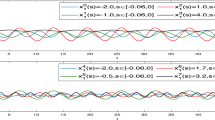Abstract
The subject of the paper is the stability analysis of some neural networks consisting of a finite number of interacting neurons. Following the approach of Dai [5] we use the fluid limit model of the network to derive a sufficient condition for positive Harris-recurrence of the associated Markov process. This improves the main result in Karpelevich et al. [11] and, at the same time, sheds some new light on it. We further derive two different conditions that are sufficient for transience of the state process and illustrate our results by classifying some examples according to positive recurrence or transience.
Similar content being viewed by others
References
S. Asmussen, Applied Probability and Queues (Wiley, New York, 1987).
P. Billingsley, Convergence of Probability Measures (Wiley, New York, 1968).
K.L. Chung, A Course in Probability Theory, 2nd ed. (Academic Press, New York, 1974).
M. Cottrell, Mathematical analysis of a neural network with inhibitory coupling, Stochastic Process. Appl. 40(1992) 103–126.
J.G. Dai, On positive Harris-recurrence of multiclass queueing networks: a unified approach via fluid limit models, Ann. Appl. Probab. 1(1995) 49–77.
J.G. Dai and G. Weiss, Stability and instability of fluid models for certain re-entrant lines, unpublished manuscript (1994).
J.G. Dai and R.J.Williams, Existence and uniqueness of semimartingale reflecting Brownian motions in convex polyhedrons, Theory Probab. Appl. 40(1) (1995).
M.H.A. Davis, Piecewise deterministic Markov processes: A general class of nondiffusion stochastic models, J. Roy. Statist. Soc. Ser. B 46 (1984) 353–388.
C. Fricker, P. Robert, E. Saada and D. Tibi, Analysis of some networks with interaction, Ann. Appl. Probab. 4(1994) 1112–1128.
E. Hewitt and K. Stromberg, Real and Abstract Analysis (Springer, Berlin, 1969).
F.I. Karpelevich, V.A. Malyshev and A.N. Rybko, Stochastic evolution of neural networks, Markov Processes Relat. Fields 1(1995) 141–161.
V.A. Malyshev, Networks and dynamical systems, Adv. in Appl. Probab. 25(1993) 140–175.
S.P. Meyn and D. Down, Stability of generalized Jackson networks, Ann. Appl. Probab. 4(1994) 124–148.
S.P. Meyn and R.L. Tweedie, Markov Chains and Stochastic Stability (Springer, Berlin/New York, 1993).
S.P. Meyn and R.L. Tweedie, Generalized resolvents and Harris-recurrence of Markov processes, Contemp. Math. 149(1993) 227–250.
S.P. Meyn and R.L. Tweedie, Stability of Markovian processes II: Continuous time processes and sample chains, Adv. in Appl. Probab. 25(1993) 487–517.
S.P. Meyn and R.L. Tweedie, Stability of Markovian processes III: Foster-Ljapunov criteria for continuous-time processes, Adv. in Appl. Probab. 25(1993) 518–548.
O. Stramer and R.L. Tweedie, Stability and instability of continuous-time Markov processes, in: Probability, Statistics and Optimisation, Wiley Series in Probability and Mathematical Statitistics: Probability and Mathematical Statistics (Wiley, Chichester, UK, 1994) pp. 173–184.
Author information
Authors and Affiliations
Rights and permissions
About this article
Cite this article
Last, G., Stamer, H. Recurrence and transience properties of some neural networks: an approach via fluid limit models. Queueing Systems 32, 99–130 (1999). https://doi.org/10.1023/A:1019135020138
Issue Date:
DOI: https://doi.org/10.1023/A:1019135020138




